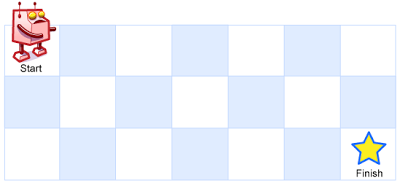There is a robot on an m x n grid. The robot is initially located at the top-left corner (i.e., grid[0][0]). The robot tries to move to the bottom-right corner (i.e., grid[m - 1][n - 1]). The robot can only move either down or right at any point in time.
Given the two integers m and n, return the number of possible unique paths that the robot can take to reach the bottom-right corner.
The test cases are generated so that the answer will be less than or equal to$2 * 10^9$ .
Example 1:
Input: m = 3, n = 7
Output: 28
Example 2:
Input: m = 3, n = 2
Output: 3
Explanation: From the top-left corner, there are a total of 3 ways to reach the bottom-right corner:
- Right -> Down -> Down
- Down -> Down -> Right
- Down -> Right -> Down
Constraints:
- 1 <= m, n <= 100
Problem can be found in here!
Solution 1: Math
def uniquePaths(m: int, n: int) -> int:
return comb(m+n-2, n-1)Explanation: There are m+n-2 steps to move from top-left to bottom-right. In m+n-2 steps, there are m-1 steps we have to move down and n-1 steps we have to move right. Simply put, we need to calculate how many ways we could choose m-1 down moves from m+n-2 moves, or n-1 right moves from m+n-2 moves. Therefore, the solution is .
Time Complexity: , Space Complexity:
, where m is the number of rows and n is the number of columns.
Solution 2: Dynamic Programming
def uniquePaths(m: int, n: int) -> int:
memo = [1] * n
for _ in range(1, m):
for j in range(1, n):
memo[j] = memo[j - 1] + memo[j]
return memo[-1] if m and n else 0Time Complexity:

